-
Training
- Flow Cytometry Basic Training
-
Product-Based Training
- BD FACSDiscover™ S8 Cell Sorter Product Training
- Accuri C6 Plus Product-Based Training
- FACSAria Product Based Training
- FACSCanto Product-Based Training
- FACSLyric Product-Based Training
- FACSMelody Product-Based Training
- FACSymphony Product-Based Training
- HTS Product-Based Training
- LSRFortessa Product-Based Training
- Advanced Training
-
- BD FACSDiscover™ S8 Cell Sorter Product Training
- Accuri C6 Plus Product-Based Training
- FACSAria Product Based Training
- FACSCanto Product-Based Training
- FACSLyric Product-Based Training
- FACSMelody Product-Based Training
- FACSymphony Product-Based Training
- HTS Product-Based Training
- LSRFortessa Product-Based Training
- United States (English)
-
Change country/language
Old Browser
This page has been recently translated and is available in French now.
Looks like you're visiting us from {countryName}.
Would you like to stay on the current country site or be switched to your country?
Overview
The BD® Single-Cell Multiplexing Kits allow you to combine and simultaneously process up to 24 different samples in one single-cell multiomics experiment on the BD Rhapsody™ Single-Cell Analysis System. The kits are designed to work with all BD Rhapsody™ Assays and include streamlined informatics tools integrated into the BD Rhapsody™ Bioinformatics Analysis Pipeline to automatically demultiplex by Sample Tags and identify individual samples during data analyses.
Learn more from the BD® Single-Cell Multiplexing Kit brochure.
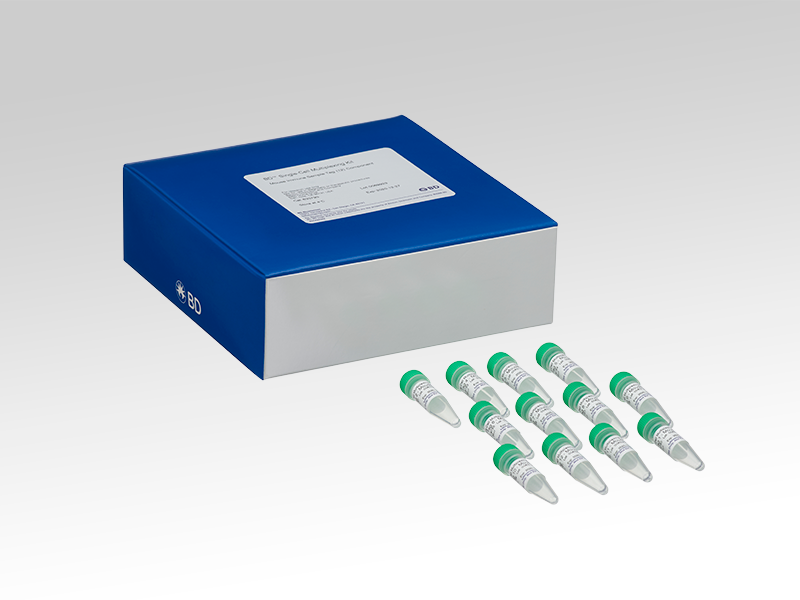
Find the right BD® Single-Cell Multiplexing Kit product for your single-cell multiomics study
| BD® Hu Single-Cell Multiplexing Kit | BD® Ms Single-Cell Multiplexing Kit | Custom BD® Single-Cell Multiplexing Set | BD® Flex Single-Cell Multiplexing Kits (A, B, C, D) | |
| Catalog No. | 633781 | 633793 | 626545 | 633849 633850 633851 633852 |
| Reactivity | Human | Mouse | Mouse | Species agnostic |
| Antibody | A universal human antibody | Anti-Mouse CD45, Clone 30-F11 | Anti-Mouse MHC-H2 Class I, clone M1/42 | Anti-R-Phycoerythrin (PE), Clone E31-1459 |
| Sample Tagging Approach | Direct labeling | Direct labeling | Direct labeling | Two-step labeling |
| Plexy | Up to 12-plex | Up to 12-plex | Up to 12-plex | Up to 24-plex |
FEATURES
The BD® Single-Cell Multiplexing Kits
- Can lower experimental cost by multiplexing up to 24 individual samples per BD Rhapsody™ Cartridge lane on the BD Rhapsody™ 8-Lane Cartridge
- Include optimized antibody tagging plus informatics tools, enabling you to experience true sample-to-answer assays
- Improves data quality by allowing you to identify and remove erroneous data from cell multiplets originating from separate samples through sample tagging
- Are tested to work across a broad range of cell type and tissue samples
The BD® Single-Cell Multiplexing Kit identifies cell multiplets yielding high-quality single-cell output
t-SNE analysis of single-cell gene expression profile with the BD® Hu Single-Cell Multiplexing Kit and BD Rhapsody™ Human Immune Response Panel. A. Cells are colored by annotation from the Sample Tag determination algorithm within the BD Rhapsody™ Bioinformatics Analysis Pipeline. B. Blue cells highlight multiplets identified. C. t-SNE plot with multiplets and undetermined cells removed to obtain cleaner data for analysis.
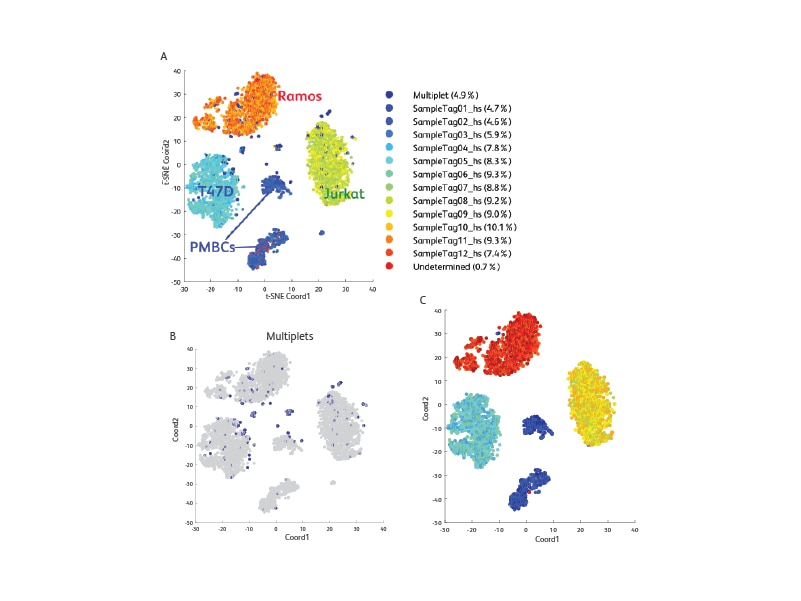
The BD® Single-Cell Multiplexing Kit shows high sample multiplexing sensitivity and specificity
t-SNE analysis of single-cell gene expression profile with 24 Sample Tags in the BD® Flex Single-Cell Multiplexing Kits and BD Rhapsody™ Human Immune Response Panel. Cells are clustered based on 399 genes in the BD Rhapsody™ Human Immune Response Panel. The expected 3 phenotypically distinct populations clusters corresponding to Human B cell (Ramos, blue cells), T cell (Jurkat, yellow and green cells), and Monocytes (THP1, red and brown cells) are obtained. High sample multiplexing sensitivity (>99%) and specificity (>95%) are achieved with 24 Sample Tags.
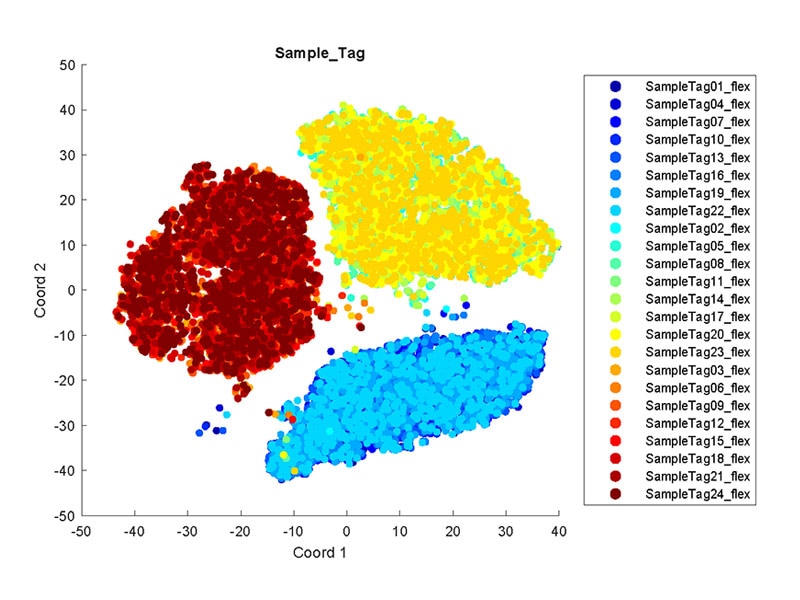
The BD® Single-Cell Multiplexing Kit can be used to increase the number of cells loaded and analyzed while maintaining a low rate of unidentified multiplets
t-SNE visualization of cell clusters in the 12 Sample Tag experiment with the BD Rhapsody™ System using the Immune Response Panel (right). A. Annotation of major cell types identified by their markers, with putative multiplet clusters in between major clusters, many of which are identified using Sample Tags. B. Highlight of Sample Tag-identified multiplets: multiplets can be identified using Sample Tags even within one cell type cluster. C. Removal of multiplets identified by Sample Tags and their associated putative clusters yields cleaner single-cell RNA-seq data.
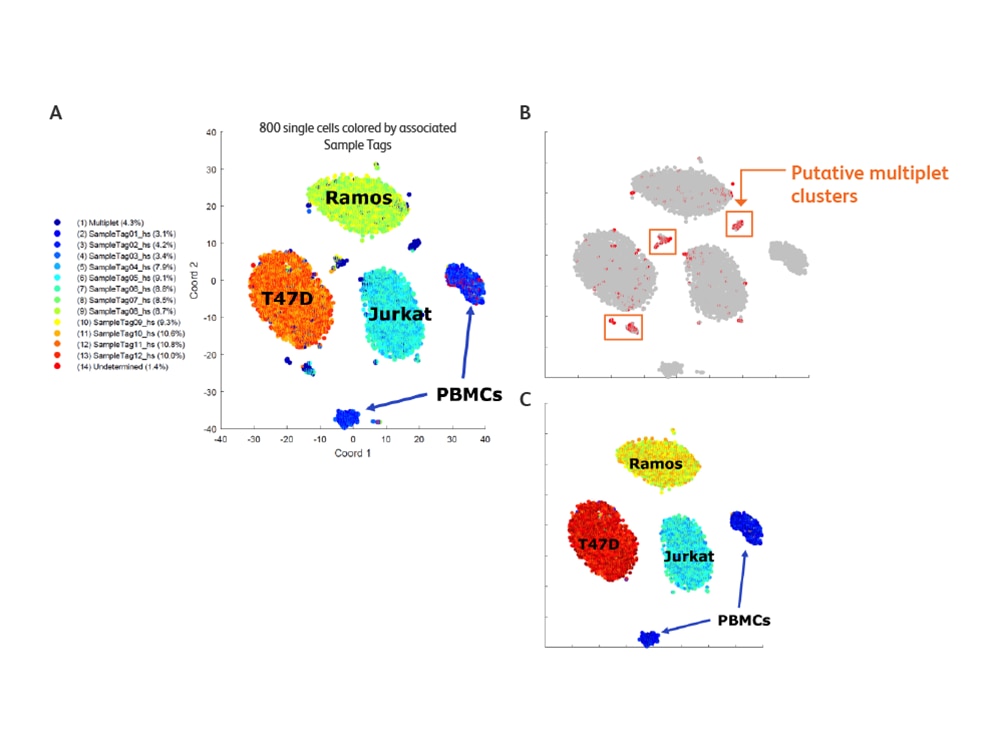
The BD® Single-Cell Multiplexing Kit can be used with single-cell suspension samples to identify multiplets
Visualization of Jurkat-only cluster (Sample Tags 4-6) from a 12 Sample Tag experiment (right). A. Multiplets are highlighted as blue points within the Jurkat cluster. Note that many Jurkat multiplets are located on the top-left of the cluster. B. Top-left putative cells identified in the Jurkat cluster are associated with higher detection of genes per cell. C. Extracting total mRNA molecules detected per putative cell revealed that cells identified as multiplets by Sample Tags have higher molecule detection, suggesting that they are bona fide multiplets.
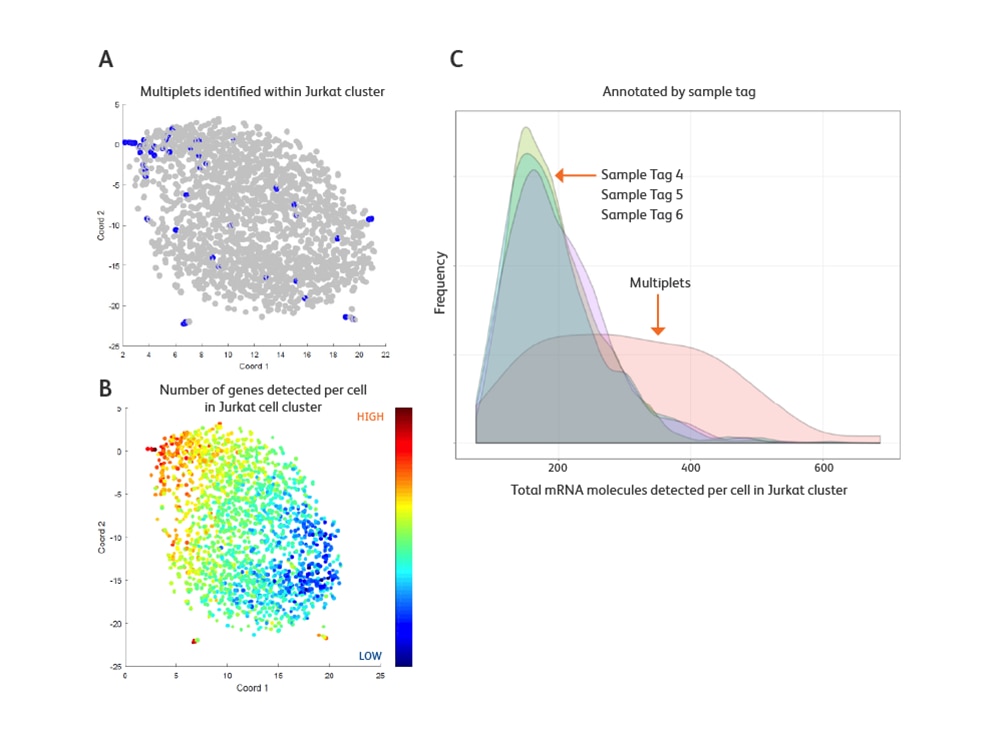
-
Brochures
-
Data Sheets
-
Technical Note
For Research Use Only. Not for use in diagnostic or therapeutic procedures.
Report a Site Issue
This form is intended to help us improve our website experience. For other support, please visit our Contact Us page.
